
A circle discussion in Wilkie’s homeroom.
More than 50 Roosevelt University students have been trained by the Mansfield Institute for Social Justice and Transformation since 2010 in how to use restorative justice practices when working with young people.
Now, some of those trainees, who have since graduated from the University, are putting what they learned to practice in their careers.
For instance, Roosevelt alumna Emily Wilkie (BA, ’13), who spent two years working with Mansfield as a peacekeeper in several area schools before deciding to teach, has helped institute restorative justice practices at her charter school in Chicago’s Austin neighborhood.

Roosevelt alumna Emily Wilkie (BA, ’13).
Tim Crawford, a 2014 graduate who took a restorative justice class at Roosevelt, is today working in the restorative justice field as a reclaiming interventionist with middle and high school students at an alternative school in Hillside, Ill.
And former Roosevelt student Matt Schiavone, a Mansfield intern at area schools and strong believer in the power of restorative justice, is implementing what he learned today as a program coordinator at a youth drop-in center in La Grange, Ill.
“Learning about restorative justice changed my life,” said Wilkie, who has helped change the culture at the Catalyst Circle Rock Charter School in Chicago’s Austin neighborhood.
Initiating peace circles in her homeroom shortly after being hired, Wilkie has helped change the culture of the school, from one that strictly tracked students’ bad behavior with demerit points, to a place where students and staff are encouraged to iron out differences in peace circles being held regularly at the school today.
“There’s been a total shift in mindset at the school, thanks to restorative justice,” said Wilkie. “It has been changing my kids’ learning outcomes for the better and I’m proud that I have been able to advocate for something that really matters in their lives, for the school and our society.”
As a reclaiming interventionist this fall at the Regional Safe School, an alternative school for middle and high school students in Chicagoland’s west suburban Hillside, Crawford has led circles on relationship building, community building and best teaching practices.
“I’ve been helping to develop and implement restorative practices at the school,” said Crawford, “and I can already see some changes for the better in relationships between teachers and students.”
“We had students who hated one another, and now they’re coming together and putting their pettiness aside,” added Crawford, who credits his Roosevelt experience with preparing him to lead the school’s restorative justice initiative.
Meanwhile, Schiavone believes his experience as a Roosevelt peacekeeper at a middle school in Chicago not only prepared him, but was key in his landing a job as programming coordinator at the Leader Shop, a nonprofit youth center in Chicagoland’s west suburban La Grange.
“At Mansfield, we would have talking circles and I applied that same framework to help diffuse some of the conflicts, disrespect, bullying and arguments we were seeing with kids in our summer camp,” he said.
The first to acknowledge having made some poor choices in high school, Schiavone said he believes in restorative justice in large part because it gives victims a say in determining outcomes of a dispute, while perpetrators get the chance to apologize.
“I had to learn the hard way in my life,” Schiavone said. “But I believe that restorative justice can make it easier for our young people to avoid mistakes and stay on track.”
Leave a Reply